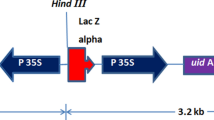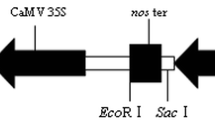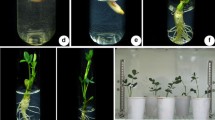Abstract.
The presence of undesirable plants in sugarcane (Saccharum officinarum L.) plantations reduces crop yields. Using genetic engineering as a complement for traditional breeding methods it is possible to introduce herbicide-resistant traits into Saccharum germplasm. Transgenic sugarcane plants resistant to phosphinothricine (PPT), the active compound of the commercial herbicide BASTA were generated by Agrobacterium tumefaciens-mediated transformation. Meristematic sections of sugarcane were treated with anti-necrotic compounds to minimize oxidative bursts and used as explants. Four transformation protocols were assessed and the transformation frequencies reached 10–35%. The regeneration rate was high and did not appear to be affected by the transformation procedure. Southern blot analysis of several transformed plants indicated the integration per genome of one or two intact copies of the bar gene which encodes PPT acetyltransferase and confers resistance to BASTA. The levels of BASTA resistance were evaluated under greenhouse and small-plot conditions.
Similar content being viewed by others
Author information
Authors and Affiliations
Additional information
Received: 8 November 1997 / Accepted: 22 November 1997
Rights and permissions
About this article
Cite this article
Enríquez-Obregón, G., Vázquez-Padrón, R., Prieto-Samsonov, D. et al. Herbicide-resistant sugarcane (Saccharum officinarum L.) plants by Agrobacterium-mediated transformation. Planta 206, 20–27 (1998). https://doi.org/10.1007/s004250050369
Issue Date:
DOI: https://doi.org/10.1007/s004250050369




